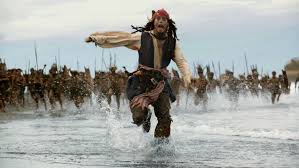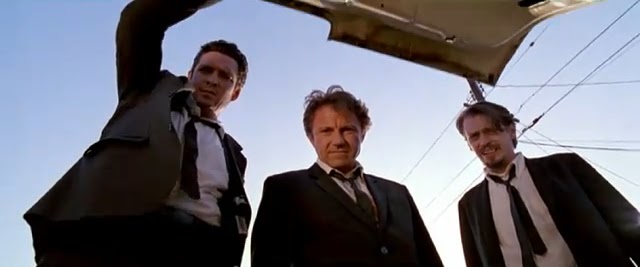What are the different camera shots and angles?
Camera Shots:
| Extreme long shot |
Extreme long shots:This form of shot is taken from a long way away, up to a quarter of a mile, and is used to give a general impression of the scene as not much detailed will be included in the shot due to the distance. It is generally used as an scene-setting/establishing shot as it gives the general impression of what is about to take place; for example an exterior of a building or landscape within which action is taking/about to take place. The picture to the left is an example taken from Harry Potter, showing how this kind of shot can be used to set the scene and indicate to the audience where the next part of the story is about to take place.
 |
| Long Shot |
Medium shots:
 |
| Medium shot |
Close up shots:
This type of shot shows very little background and focus in on one aspect of the scene, such as writing on paper or a facial expression; as depicted by the picture on the right. It is used to attract the audience's attention to the more important aspects of the mis-en-scene which the film maker really wants us to notice. Due to the closeness of the shot, it also creates a sense of intimacy with the audience as in real life we would only let people we really trust get into that proximity of us, so the audience feels closer to the character being shown.
| Extreme close up |
Extreme close up shots:
This type of shot usually focuses in on an aspect of the mis-en-scene very dramatically, magnifying beyond what the human eye would naturally be able to see. Therefore it would not contain any
background at all, drawing the audience's full attention to that particular aspect as they have no choice but look at what is contained in the shot. As shown in the picture on the left, it adds a lot more definition to the shot and can thus be used for dramatic effect; such as showing the emotion in someone's eyes.
Camera angles
Birds eye view:
| Birds eye view |
High angle:
| High angle |
Eye level:
This is when the camera is positioned as if a human was actual observing the scene, thus at 'eye level'. This can make the audience feel more involved in the scene as it gives the impression that they are actually observing it as they are positioned as if they were there.
Low angle:
 |
| Low angle |
Oblique angle:
This is when the camera is titled, to suggest an imbalance/transition/instability. It can be used to give a point of view effect, so the audience feels like they are witnessing the events from the perspective of the character.
Camera movement
Pans:
A movement of the camera horizontally, usually following an object/character in the centre of the shot or can also be used to set the scene and show the setting to the audience. The camera is placed on a stationary axis to keep the camera level the entire shot.
Tilts:
This is the exact same as a panning shot, except instead of moving horizontally it moves vertically. It can be used to give the audience an entire view of a character, from head to foot.
Dolly shots:
This is when the camera is placed on a moving vehicle, for example a car or plane, and moves alongside the action; stereotypically following a character or object. This shot is very useful when tracking movement, such as in a car chase, or for acting as a transition between a long shot and a close up as the audience is gradually introduced to the character or object.
Hand held shots:
This kind of shot gives a jerky effect, as it is when someone just uses a hand held camera to capture the shot as the are going. It gives the audience a sense of realism, as they feel like they are part of the action rather than just someone watching detached from the scene.
Why use a selection of shots and angles? How does this add to the story telling?
It is important to use a range of shots and angles as it keeps the audience captivated, as if we used the same shot and the same angle repeatedly it would become boring to watch. It adds to the story telling as it allows the audience to see the scene in a variety of ways, so they have a deeper understanding of what is going on as they are led by the film maker with these different shots as to which parts of the mis-en-scene are the most important within telling that particular part of the story. The different camera shots and angles can also effect the relationship a viewer has with the content, for example lower angles are more likely to make the audience feel inferior to the character.
Examples of film openings where a particular shot/angle has been used to excellent effect:
The Blair Witch Project:
The Blair Witch Project is probably the most iconic film for its usages of the hand held shot, which is introduced from the very opening scene. It uses this type of shot perfectly as it gives off a very homemade feel; which is very fitting with the nature of the film. It adds a sense of realism that we don't get very often in hollywood, it lacks the glossy feel that most feature films have, which is appealing to an audience as it is unique to most of the other films available.
Back To The Future:
Within the first two minutes of this film panning shots are used quite heavily. They are particularly effective here because they introduce the audience into a sense of quirkiness which is continued throughout the film. It allows the viewer to get the first inkling of the vibe of the film in a very simple way; which is sometimes more effective than using an abundance of different shots and angles.
What effect do shorter shot lengths have?
Shorter shots usually connote an increase of action or something tense occurring within in the films plot. It can create dramatic tension, as the quick switches between shots means that the audience does not have time to focus on the detail within each shot, increasing the pace and action of the film. It can also be used to reflect a characters state of mind, as in an action packed scene the character is likely to be feeling jumpy and tense, which is paralleled with the quick cuts between shots. The most iconic usage of short shot lengths is probably within Hitchcock's Pyscho, where in the shower scene there is a rapid number of short shots that increases tension and even fear amongst the audience as it depicts the panic of the woman, and thus makes the audience feel panicked as well as it is quite disorientating being presented with so many different points of view in such a small period of time.
What effect do longer shot lengths have?
Longer shot lengths can also be used to create tension as they give the impression of something impending about to happen. They allow the audience to hone in on the smaller details within the shot as they are exposed to them for longer, so they can be used to strike home a particular message or emotion that is important to plot; for example if the character is having a very serious conversation the shot may be longer at the end to give the audience more time to digest the information and thus increase its impact.
No comments:
Post a Comment